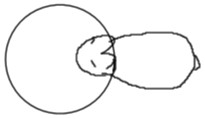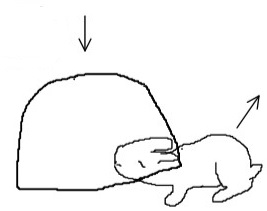No one ever wants to put down a baby bunny, but sometimes it’s necessary to prevent suffering. You may have found an injured bunny or need to cull sick, hurt, or deformed kits.
Never let a rabbit live in misery because you can’t bring yourself to do anything about it. Muster up your courage and do what needs to be done. Here are a few methods that can be used to humanely dispatch a baby rabbit. Choose the one that works best for you.
These techniques should only be used for baby rabbits. They are not humane for older rabbits. Learn how to humanely butcher rabbits over 6 weeks in our Meat Rabbit Processing Course.
Humane Dispatch:
The following methods are considered humane for baby rabbits if done correctly.
Bowl method – My preferred method – fast & easy. Works for kits up to 6 weeks old. I learned this method from my sister who worked at a pet store. It’s often used to dispatch rats and mice for feeding snakes. The animal is killed instantly through cervical dislocation.
Set the kit on a hard surface. Place an overturned bowl above its head and rest the lip of the bowl on its neck. In one smooth movement, press down on the bowl while pulling the back legs up with the other hand. Make sure to pull hard enough to dislocate the neck. Realize this may remove the head from the body. It’s better to pull too hard than not hard enough. A bowl with a narrow edge works best.
You will feel rhythmic twitching immediately after dispatch. This is normal and passes quickly. The kit is not suffering. The involuntary movements signal brain death. After 10-20 seconds the eyes open wide and will not move if touched. Watch for these two signs of death to know that the dispatch was successful.


Bag method – Place the kit in the bottom of a pillowcase or bag. Gather the top of the bag in your hand. Slam the bag quickly and sharply against pavement or cement. Repeat the movement to ensure the kit is dead.
Knife method – Works for young kits up to 2 weeks old. Not recommended for older kits. Use a large sharp knife or loppers to quickly sever the head from the body.
CO2 Chamber – Not the best option for quick, simple dispatch. Considered humane, but unless you already have a CO2 chamber, it requires a lot of work and education to do it properly. Animals have been known to pass out and appear dead then revive later.
Methods that are not humane:
Please do not use the following methods – they are cruel and cause unnecessary suffering.
Freezing – The animal slowly dies of hypothermia. They can feel ice crystals forming in their body which is very painful.
Hitting with an object – In my opinion, hitting the rabbits head with a hammer, pipe, or mallet provides too much margin for error, especially if you lack hand/eye coordination. These stun the rabbit, and rarely result in a quick painless death.
Burn in a fire/ furnace – Ouch! Need I say more?
Drowning or Suffocation – The animal struggles and panics for 1-2 minutes desperately trying to get air with this method. Far too long to be considered humane.
Let nature take its course – While this method is acceptable for minor injuries receiving treatment, it should never be used for serious injuries or infections. Letting nature take its course is cruel when the kit is obviously in pain with little or no hope of recovery.
Knife method on older kits – Not humane because their fur and spine prevent a clean cut all the way though. Dispatch kits 2-4 weeks old using one of the humane methods listed above.
Humane Rabbit Dispatch Sources:
Euthanasia Guide for Ontario Commercial Meat Rabbit Producers
Efficacy of Blunt Force Trauma for On-Farm Euthanasia of Pre-Weaned Kits – pdf download

Keywords: humane, euthanize, euthanasia, kill baby bunny, kill young rabbit, cull baby bunny, putting down rabbit, deformed rabbit kit, cull young rabbit for snake food, culling mice, cull rats for snake food, injured rabbit kit, sick baby bunny, dispatch rabbit
Related Posts:
- Meat Rabbit Pros & Con
- Breeding Meat Rabbits: From Pairing to Fryers
- Champagne d’Argent: The Color Changing Rabbit
Any thoughts on humanely dispatching baby rabbits? Comment below…






I have a 6-week-old rabbit that apparently suffered heat stroke and now has 4 splay legs and I must put it down. This is very hard any suggestions?
Sorry to hear about your rabbit. Unfortunately, sometimes these things happen despite our best efforts. I sent an email with info on emergency dispatch. If you raise rabbits, I highly recommend that you take our ‘Meat Rabbit Processing Course’ since humane rabbit dispatch is a skill that every rabbit breeder should know. Hope this helps. https://courses.homesteadrabbits.com/meat-rabbit-processing-course/
Rabbit hole/den with live kits in my backyard. Rabbits have destroyed almost everything we’ve planted. Simply don’t want them around. I was going to drown them, but opted for the bowl method. Preferred animal control to take them, but they wouldn’t. Sad day, but thank you! The adult rabbits will be shot, skinned and eaten without remorse.
I don’t raise rabbits for meat but show and 4H pets. Culling isn’t something I enjoy but we do eat or feed the ones who don’t make the cut to our cats and dogs. I had a litter from an excellent mom attacked by a rat. Only one made it unharmed and sadly Moms milk dried up. At 5 days it can’t keep warm and Mom just sort of was over the entire trauma. Hand fed it for a week only to see it miss milestones and at 16 days when it failed to gain weight and not open its eyes knew it was just prolonging the harsh reality. This article was great in helping me make the decision even if I hated to throw in the towel. Quality of life trumps quantity and the bowl method was quick and as easy as the hopper popper I use on the adults. Thanks again.
Heather, thanks for sharing your story. I agree “quality of life trumps quantity” when an animal is in slow decline. I’m proud of you for making that tough decision and doing what needed to be done.
I use a 22 long rifle and just lay the kit on the grass. ( if it was hopping, I have a little, fence wire portable kill pen… It’s quick, 22 bullets are still cheap, there’s only a little blood, and the dog gets a snack.
By the way, at what age do you recommend using methods identical to those used for dispatching adult rabbits?
Use adult dispatch methods (such as cervical dislocation) if the bunny is over 4 weeks or weighs more than 3 pounds. The methods listed above are for young kits.
Thanks for the answer. It is also known that we intuitively choose the dispatching methods that work best for us, we have our routine. I already have some experience in dispatching large rabbits and small kits, but I haven’t had to deal with something in-between.
Thank you for this guidance. I had to quickly dispatch a baby rabbit that my dog injured severely, and I did not want it to suffer any further. I used the bowl method, and the rabbit passed quickly.
I wasn’t sure I could bring myself to do it, but your words helped me step up and get over my hesitation for the sake of the injured kit: “Never let a rabbit live in misery because you can’t bring yourself to do anything about it. Muster up your courage and do what needs to be done.” Thank you.
Raising animals can be hard, especially when faced with situations like this. You did the right thing to end its suffering as humanely as possible.
Thank you for your guidance. It helped me stop the suffering of a wild kit the cat had badly injured.
Glad to hear you were able to end its suffering humanely.
“Blunt trauma – Hitting with a hammer or mallet provides too much margin for error. Death is rarely instantaneous.”
But the act of slamming against pavement while using the “bag method” doesn’t result in a death from blunt trauma? Then how does it work?
(Note, I too raise my own meat and believe we should make things as quick and painless for the animal as possible. Just wanted to point out the inconsistent logic in this post article.)
Thanks for your comment. When using a hammer or mallet, you only hit a small area. In theory, if a rabbit is hit hard at the base of the skull (where it attaches to the spinal cord) it will result in instant brain death. However, you must hit that exact spot with enough force for this method to be humane. The bag method involves hitting the whole body at once. The initial blow renders the animal unconscious and the body systems shut down rapidly. Skull fracture, spinal fracture, and internal hemorrhaging result in brain death within a few seconds. I modified the post in response to your suggestion. I hope it makes more sense now. What dispatch method do you use for kits?
Of course, everyone may have a different opinion and you need to choose the method that you feel most comfortable with, but I agree with Alyssa. When I started breeding rabbits, I got used to this way of dispatching. It’s less messy and really fast. Mostly results only with some bleeding from the nostrils, so it’s not so graphic as it seems after reading the description.